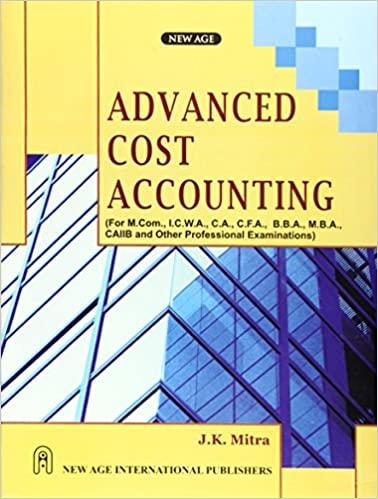Bricabrac Corporation. A new entrant in this market, Bricabrac has been selling Ends for $220 each. Knickknack's president is puzzled by Bricabrac's ability to sell Ends at such a low cost. She has asked you (the controller) to look into the matter. You have decided that Knickknack's traditional, volume-based product-costing system may be causing cost distortion between the firm's two products. Ends are a high-volume, relatively simple product. Odds, on the other hand, are quite complex and exhibit a much lower volume. As a result, you have begun work on an activity-based costing system. You have gathered the following additional information: - Each odd requires 4 machine hours, whereas each end requires 1 machine hour. - Odds are manufactured in production runs of 50 units each. Ends are manufactured in 250-unit batches. - Three-quarters of the engineering activity, as measured in terms of change orders, is related to Odds. - The plant has 1,920 square feet of space, 80 percent of which is used in the production of Odds. For each activity cost pool, compute a pool rate. (Hint: Regarding the pool rate, refer to Exhibit 5-6.) 4. Compute the new product cost per unit for Odds and Ends, using the ABC system. Note: Round your intermediate calculations and final answers to 2 decimal places. [The following information applies to the questions displayed below.] Knickknack, Incorporated, manufactures two products: Odds and Ends. The firm uses a single, plantwide overhead rate based on direct-labor hours. Production and product-costing data are as follows: Calculation of predetermined overhead rate: Predetermined overhead rate: Budgeted manufacturing overhead Budgeted direct-labor hours =$816,000((1,000)(2)+(5,000)(3))=$48 per directlabor hour Knickknack, Incorporated, prices its products at 120 percent of cost, which yields target prices of $199.20 for Odds and $298.80 for Ends. Recently, however, Knickknack has been challenged in the market for Ends by a European competitor, Bricabrac Corporation. A new entrant in this market, Bricabrac has been selling Ends for $220 each. Knickknack's president is puzzled by Bricabrac's ability to sell Ends at such a low cost. She has asked you (the controller) to look into the matter. You have decided that Knickknack's traditional, volume-based product-costing system may be causing cost distortion between the firm's two products. Ends are a high-volume, relatively simple product. Odds, on the other hand, are quite complex and exhibit a much lower volume. As a result, you have begun work on an activity-based costing system. 7. Calculate the total amount of product cost distortion for entire product line caused by Knickknack's traditional, volume-based costing system. (Refer to Exhibit 5-10 for guidance). Note: Negative amounts should be indicated by a minus sign. 5. Using the same pricing policy as in the past, compute prices for Odds and Ends. Use the product costs determined by the ABC system. Note: Round your intermediate calculations and final answers to 2 decimal places. Bricabrac Corporation. A new entrant in this market, Bricabrac has been selling Ends for $220 each. Knickknack's president is puzzled by Bricabrac's ability to sell Ends at such a low cost. She has asked you (the controller) to look into the matter. You have decided that Knickknack's traditional, volume-based product-costing system may be causing cost distortion between the firm's two products. Ends are a high-volume, relatively simple product. Odds, on the other hand, are quite complex and exhibit a much lower volume. As a result, you have begun work on an activity-based costing system. You have gathered the following additional information: - Each odd requires 4 machine hours, whereas each end requires 1 machine hour. - Odds are manufactured in production runs of 50 units each. Ends are manufactured in 250-unit batches. - Three-quarters of the engineering activity, as measured in terms of change orders, is related to Odds. - The plant has 1,920 square feet of space, 80 percent of which is used in the production of Odds. For each activity cost pool, compute a pool rate. (Hint: Regarding the pool rate, refer to Exhibit 5-6.) 4. Compute the new product cost per unit for Odds and Ends, using the ABC system. Note: Round your intermediate calculations and final answers to 2 decimal places. [The following information applies to the questions displayed below.] Knickknack, Incorporated, manufactures two products: Odds and Ends. The firm uses a single, plantwide overhead rate based on direct-labor hours. Production and product-costing data are as follows: Calculation of predetermined overhead rate: Predetermined overhead rate: Budgeted manufacturing overhead Budgeted direct-labor hours =$816,000((1,000)(2)+(5,000)(3))=$48 per directlabor hour Knickknack, Incorporated, prices its products at 120 percent of cost, which yields target prices of $199.20 for Odds and $298.80 for Ends. Recently, however, Knickknack has been challenged in the market for Ends by a European competitor, Bricabrac Corporation. A new entrant in this market, Bricabrac has been selling Ends for $220 each. Knickknack's president is puzzled by Bricabrac's ability to sell Ends at such a low cost. She has asked you (the controller) to look into the matter. You have decided that Knickknack's traditional, volume-based product-costing system may be causing cost distortion between the firm's two products. Ends are a high-volume, relatively simple product. Odds, on the other hand, are quite complex and exhibit a much lower volume. As a result, you have begun work on an activity-based costing system. 7. Calculate the total amount of product cost distortion for entire product line caused by Knickknack's traditional, volume-based costing system. (Refer to Exhibit 5-10 for guidance). Note: Negative amounts should be indicated by a minus sign. 5. Using the same pricing policy as in the past, compute prices for Odds and Ends. Use the product costs determined by the ABC system. Note: Round your intermediate calculations and final answers to 2 decimal places










